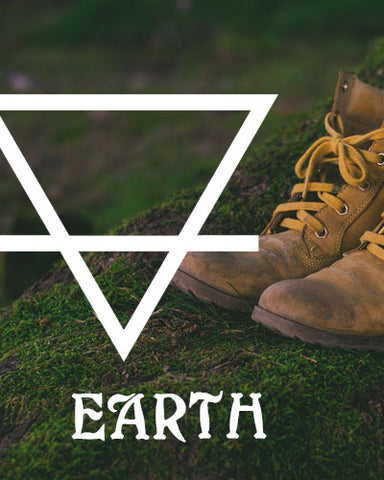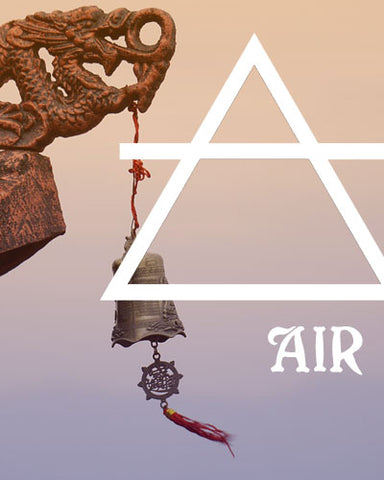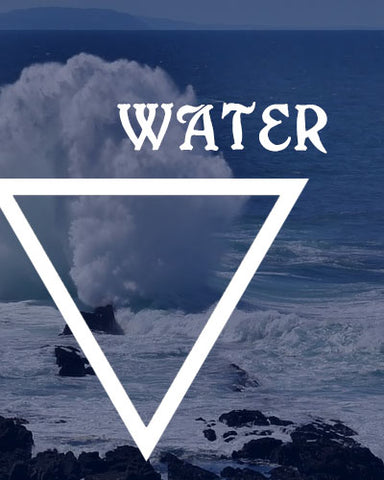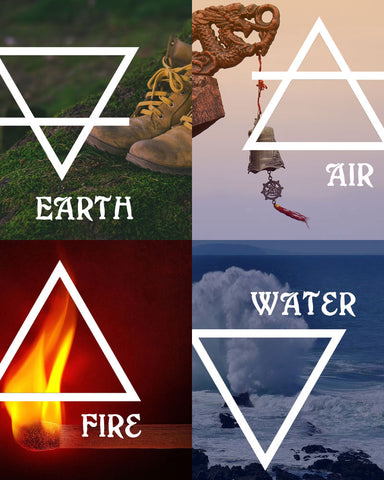Connecting to the powers of the Four Elements is a foundational practice for many Pagans. Earth, Air, Fire, and Water move through us and inspire us. As ideas, they help us to make sense of and to describe a complex world. Even the simplest of Pagan altars usually have some representation of the Elements.
Some Pagans have specific ritual tools consecrated to each one of the Elements. (The Wand, Cup, Disk, and Sword are the canonical tools of the ceremonial magician.) Others take a more spontaneous approach, grabbing everyday items that symbolize the elemental powers. There are traditional and non-traditional ways to evoke the four elements.
Speaking of which, there are no rules when creating an elemental altar. There is no such thing as a “perfect” elemental tool. Remember that every object you might find on Earth contains more than one elemental energy blended together. Just choose things that are meaningful to you and that appear harmonious when brought together. The lists provided below are suggestions only. (Your tradition may have others.)
Here are some different ways to represent the Elements on a Pagan altar:

The Element: Earth
Traditional Tool: Pentacle or Disk
The meaning of Earth: Earth is perhaps the most overlooked Element in Pagan magick. Earth is everywhere, and it appears passive. It doesn’t really “do” anything with the same force as Air, Fire, or Water.
Yet the Earth gives us our birth. While we live, it sustains us. When we die, it covers us. Earth encompasses a multitude of magickal ideas: Nourishment, protection, obstruction, wholeness, stillness, plant and animal life, interdependence, prosperity and rest. The objects that can represent Earth are similarly diverse.
Altar Objects for Earth:
Pentacle
The altar (base) itself
Plate, paten, or disk
Ceramics
Cast metal
Coin
Rock or stone
Dish of soil, sand or salt
Food (especially fruits, vegetables or grain foods)
Flowers or herbs
Cauldron
Labyrinth
Gems (Garnet, Hematite, Jasper, Aventurine)
Candle (Green, brown, or black)
Deity statue (Gaia, Macha, Saturn/Chronos, Pan)
Horn or bone
Acorns
Seeds
Images of trees and mountains
Gnomes
Animal art (Cattle, Tortoise, Rabbit, Deer)
Oil (Patchouli, Vetivert, Evergreen)
Altar tile decorated with symbol of Earth
Tarot Ace of Pentacles

The Element: Air
Traditional Tool: Sword (or Wand, in some traditions)
The meaning of Air: As Air passes over the still Earth, the world moves into action and consciousness. Air is the Element of communication, exchange, and ideas. Air is invisible—we know it only through its effects on the world.
Air is also swift-moving, changeable and self-aware. It is the most human of all the Elements. Choose your Air items based on what Air means to you at the time you’re assembling the altar.
Altar Objects for Air:
Athame or sword
Wand or staff
Feather
Windchimes
Bell
Incense
Lamp or lantern (symbolizing knowledge)
Fan
Book
Spoon or stirrer
Wheel
Wind-blown flowers and seeds
Brightly colored ribbon or streamers
Crystals (Clear Quartz, Citrine, Smoky Quartz/Topaz)
Candle (Yellow or white)
Musical instrument (especially strings or woodwinds)
Images of clouds and sky
Animal art (Birds, Dragonfly, Butterfly)
Angels
Fairies
Air freshener or diffuser
Deity statues (Hermes, Thoth, Saraswati)
Oil (Eucalyptus, Peppermint, Lavender)
Altar tile decorated with symbol of Air
Tarot Ace of Swords

The Element: Fire
Traditional Tool: Wand (or Sword, in some traditions)
The meaning of Fire: Elemental Fire is the pure power of heat and light. The energy of Fire is strong, primal, and often dangerous. In Fire, we find the heat of passion and the warrior’s fighting spirit. Esoteric meanings of Fire include courage, willpower, lust, protection, spiritual aspiration, destruction and impending renewal.
Altar Objects for Fire:
Wand
Flame (candle, lamp, or brazier)
Lighter or matches
Spicy foods
Phallus
Incense
Cactus or thorns
Candle (Red, orange, or gold)
Dragons
Images of flames or the sun
Volcanic stones or ash
Bright yellow or orange plants
Gemstones (Ruby, Carnelian, Amber, Opal)
Pyramid
Djinn/Salamander
Oil (Cinnamon, Frankincense, Dragon’s Blood)
Deity statues (Ra, Vulcan, Brigid, Pele, Sekhmet)
Animal art (Lion, Lizard, Phoenix)
Altar tile decorated with symbol of Fire
Tarot Ace of Wands

The Element: Water
Traditional Tool: Cup
The meaning of Water: Water is the great partner of Earth in creating life as we know it. Like Earth, Water appears gentle, but contains immense potential power. It is cleansing, calming, and healing. Elemental Water also governs the magick of love and emotion, intuition, pleasure, and introspection.
Altar Objects for Water:
Chalice, cup, or goblet
Beverages (especially water or wine)
Scrying bowl or crystal ball
Rainwater
Blessed or holy water
Seashell
Yoni
Driftwood or seaweed
Gemstones (Aquamarine, Lapis Lazuli, Sodalite, Amethyst)
Ankh
Mirror
Mermaids
Images of ocean, rivers, or lakes
Candle (Blue)
Oil (Rose, Lotus, Jasmine)
Animal art (Fish, Dolphin, Frog)
Deity statue (Poseidon, Aphrodite, Yemaya)
Altar tile decorated with symbol of Water
Tarot Ace of Cups
I hope you enjoy putting together your elemental altar! Read more articles here, or go to the main store page.

